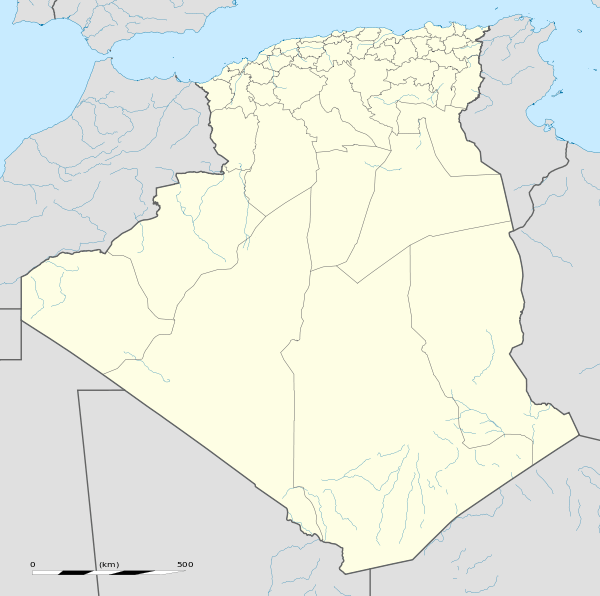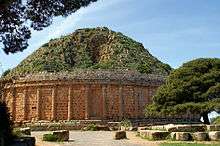Tiddis
 Ruins of Tiddis | |
 Shown within Algeria | |
| Location | Algeria |
|---|---|
| Region | Constantine Province |
| Coordinates | 36°27′48″N 6°29′02″E / 36.463333°N 6.483889°E |
Tiddis (also known as Castellum Tidditanorum or Tiddi[1]) was a Roman city that depended on Cirta. It was located on the territory of the current commune of Bni Hamden in the Constantine Province of eastern Algeria.[2]
History
Today, Tiddis is an authentic Roman site called Res eddar or the "peak of the House" located in the Gorge of the Khreneg, just north of Cirta.[3] It marks the presence of a Roman civilization through rock art inscriptions and Roman pottery.
Tiddis was built by the Romans and arranged according to their system of urbanization.[4][5]
| Part of a series on the |
| History of Algeria |
|---|
 |
|
|
|
|
Modern times |
|
|
This prosperous town, established on a plateau, had a monumental gate, baths, industrial facilities (tanneries), a sanctuary to Mithras dating back to the 4th century BC, and also a Christian chapel.[6][7]
The native town became Romanized just like the other towns near Cirta. Today one can cross it by following the main street as it goes from a monumental portal up between the houses, passing by the forum, a small square, and the curia. From inscriptions one knows the magistrates and decurions of the castellum. It belonged to the colony of Cirta and, with the other colonies of Rusicade, Milev, and Chullu, formed part of the confederation of the IV colonies. Also among the public monuments cleared thus far are the public baths and cisterns (built by M. Cocceius Anicius Faustus in the middle of the 3d c. A.D.) and on top of the crag a Temple of Saturn (which produced a great number of stelae now in the Constantine Museum). On the slopes of the cliff one can see many houses and the remains of the original rampart of the castellum. The Lollii were one of the important families of the town. Their circular mausoleum can still be seen some kilometers to the N. The monument was erected by Lollius Urbicus, prefect of the city of Rome under Antoninus Pius. At the end of the 5th c. the town is known to have been the seat of a bishopric. Two Christian basilicas have been cleared. One was located at the entrance of the town; the other was in a more distant district and has been only partially cleared. — Perseus[8]
Castles and water tanks of all forms remind us that the city has gradually been abandoned because it lacked sources. One can admire the mausoleum that Quintus Lollius Urbicus, a native of Tiddis (and son of a romanised Berber landowner) who then became prefect of Rome.[1][9]
Under Byzantine control, Castellum Tidditanorum had two small churches and was the See of a Diocese.[10] The Christian community probably disappeared with the Arab conquest in the second half of the 7th century, but some pottery remains showed the survival of a small village inside the ruins of Tiddis until the 9th century.[11]
Famous people
Notes
- 1 2 Jérôme Carcopino, "Le travail archéologique en Algérie pendant la guerre (1939-1942)" in Comptes rendus des séances de l'Académie des Inscriptions et Belles-Lettres, Year 1942, Volume 86, Issue 4-6, p. 307
- ↑ Mounir Bouchenaki, ancient cities of Algeria, collection Art and Culture No. 12, Algiers, Ministry of Information and Culture, 1978 (114 p.) (ISBN 84-399-7904-5)
- ↑ Detailed map, showing the location of Castellum Tidditanorum just north of Roman Cirta
- ↑ Serge Lancel, the ancient Algeria, Editions Mengès, 2003, (ISBN 2-85620-431-7)
- ↑ André Berthier, Tiddis, cited ancient Numidia, les Belles lettres, 2000 Acad.
- ↑ André Berthier, the Numidia, Rome and the Maghreb, Ed.picard, 1981.
- ↑ André Berthier, R.S. Davis and c. Ogle, new research on the Bellum Jugurthinum, 2001.
- ↑ Perseus: Tiddis
- ↑ André Berthier, j. July, r. Charlier, the Bellum Jugurthinum of Sallust and the problem of Chen, R.S.A.C., 1949
- ↑ Tiddis, with some photos (in Italian)
- ↑ Andre Berthier. "Tiddis", Introduction
Bibliography
- Berthier, André. Tiddis. Antique Castellum Tidditanorum Academie des Belles lettres. Paris, 1951
See also
Coordinates: 36°27′48″N 6°29′02″E / 36.46333°N 6.48389°E
%2C_Algeria_04966r.jpg)